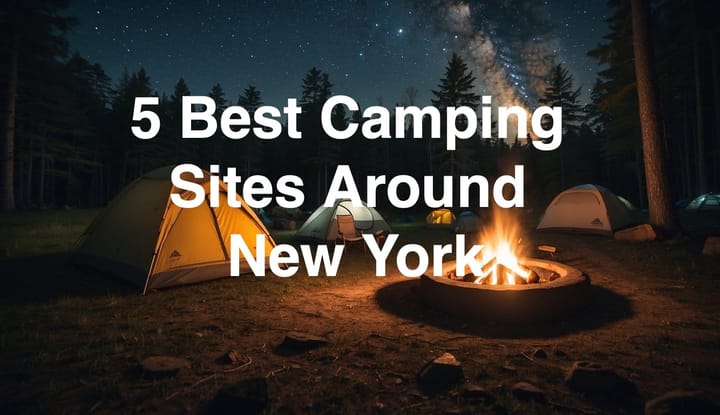Winter Camping
Winter camping offers an opportunity to experience the tranquility and stark beauty of the outdoor landscape in its most serene state.
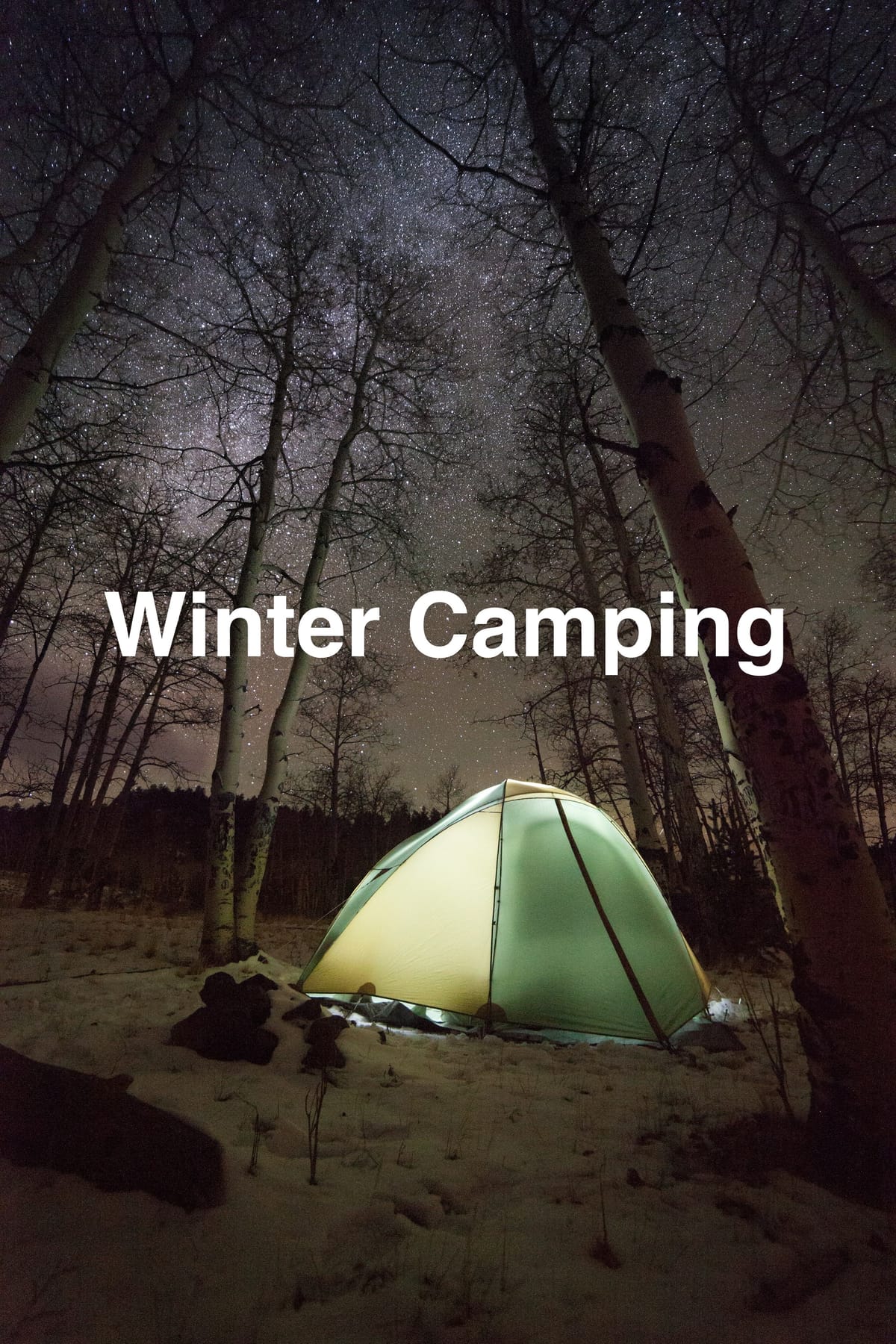
As you prepare to embark on this cold-weather adventure, it's essential to understand the unique challenges that come with it.
Unlike its summer counterpart, winter camping requires additional planning, the right gear, and strategies to ensure you remain warm and safe.
Your preparation will revolve around overcoming the cold and the inhospitable nature of winter wilderness.
Ensuring your comfort during a winter campout hinges on having the appropriate clothing, a suitable campsite setup, and proper nutrition.

Layering systems are pivotal in regulating body temperature, and your campsite should be crafted with careful consideration to the environment to guard against the elements.
Knowledge is just as important as your equipment; familiarize yourself with winter survival techniques and always be prepared for the unexpected.
Key Takeaways
- Proper planning ensures a safe and enjoyable winter camping experience.
- Investing in the right gear is crucial for warmth and safety in cold conditions.
- Knowledge of clothing layering, campsite setup, and nutrition enhances comfort.
Planning Your Trip
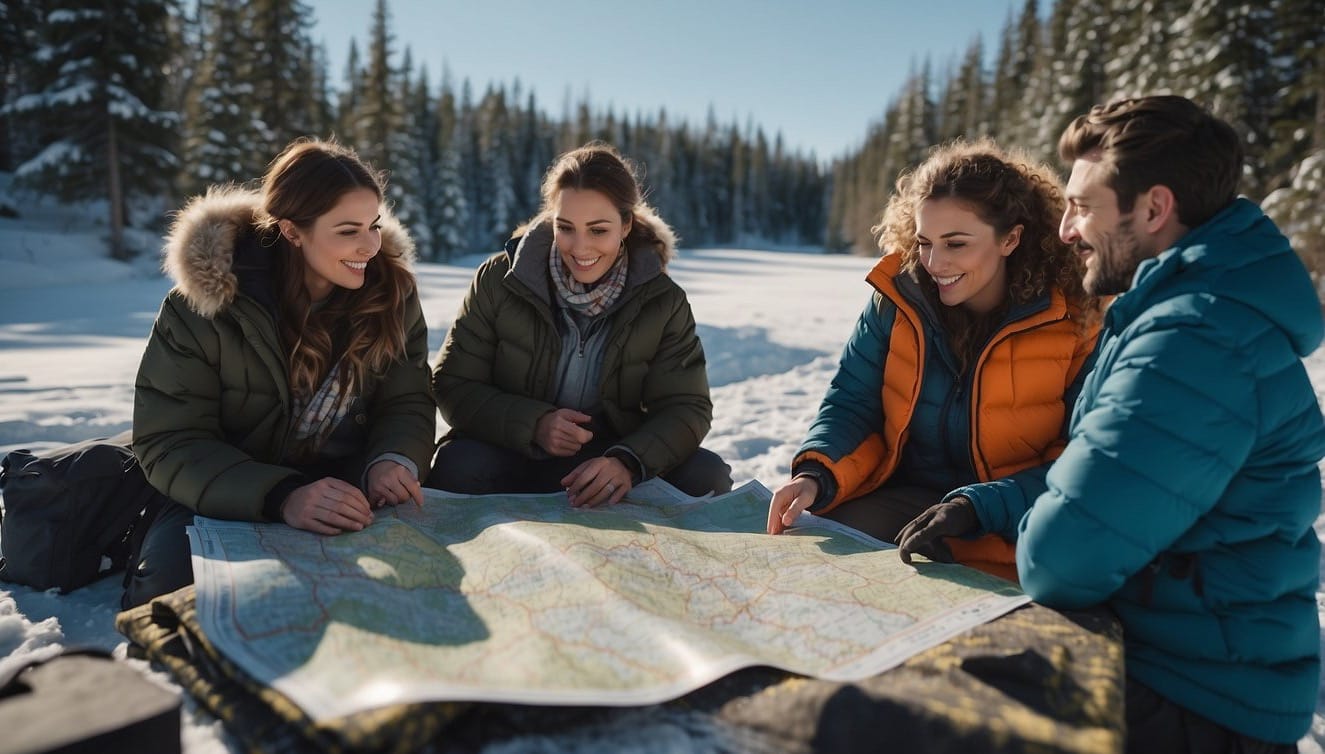
Before venturing out into the winter wilderness, it is essential to meticulously plan your trip. This ensures your safety and maximizes your enjoyment.
Selecting the Right Date
Choose your camping dates with close attention to the seasonal weather patterns and historical data.
The ideal time frame not only affects your comfort but also your safety. Aim for a window with stable weather conditions and minimal avalanche risks, typically mid-winter when temperatures are constant.
Understanding Winter Weather
Acquire a detailed weather forecast from a reliable source before departure.
Understand the implications of predicted temperatures, snowfall, and wind chill factors.
Knowledge of avalanche safety is crucial; learn to interpret local avalanche forecasts and familiarize yourself with the terrain to identify potential avalanche risk areas.
Safety and Emergency Preparedness
Your safety hinges on the essentials: a map and compass or GPS device for navigation, a comprehensive first aid kit, and the means to signal for help.
Ensure your emergency plan includes informing someone of your itinerary and expected return time. In the backcountry, a personal locator beacon (PLB) can be a lifeline.
- Safety Checklist:
- Navigation tools (map and compass or GPS)
- First Aid Kit, including cold-weather specific items
- Avalanche safety gear (if necessary)
- Emergency shelters (bivy sack or space blanket)
- Signaling devices (whistle, mirror, PLB)
Essential Winter Camping Gear
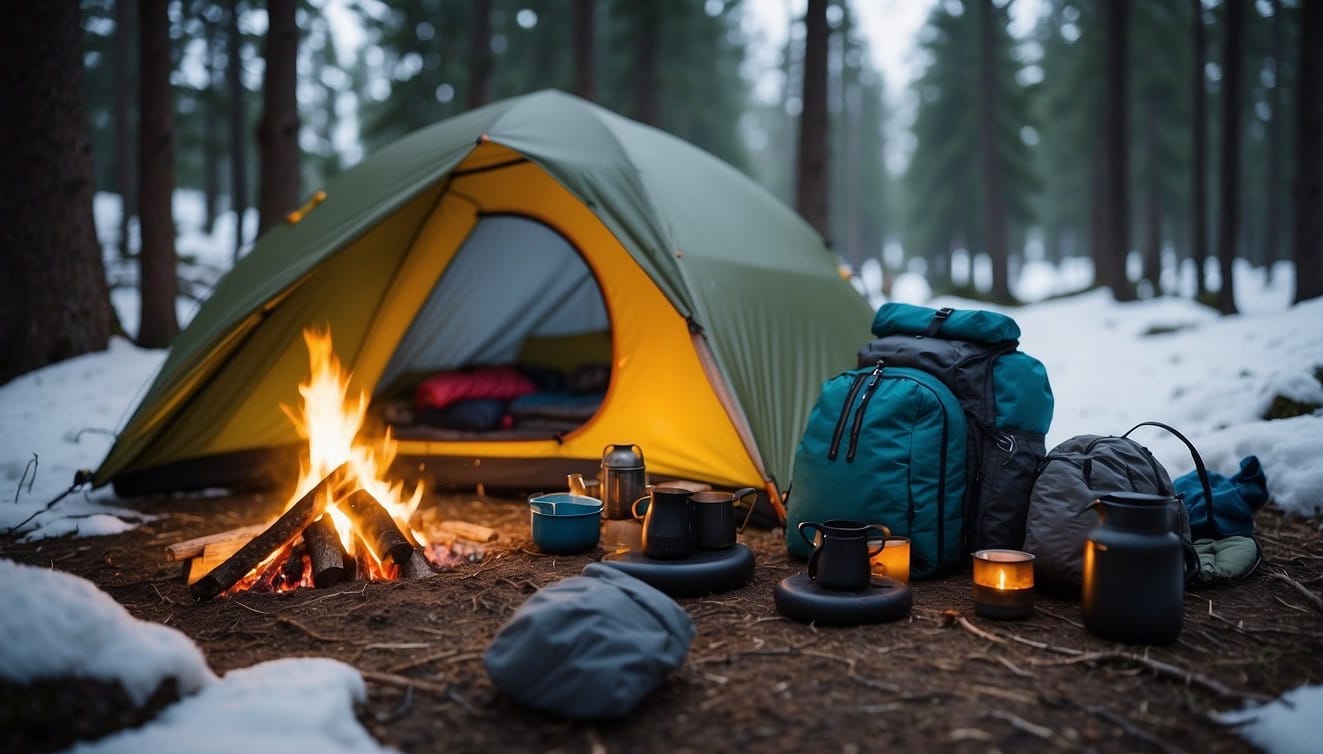
When heading out for winter camping, the right gear is critical for your safety and comfort.
Pay attention to the durability and insulation features of your equipment to ensure you're equipped to handle the cold.
Choosing a Winter Tent
When selecting a winter tent, opt for a 4-season tent.
These tents are designed with sturdier poles and heavy-duty fabric to withstand harsh winter conditions, including snow and high winds.
The geodesic or dome structure of these tents helps resist snow accumulation, which could otherwise collapse a tent not suited for winter.
The Importance of a Quality Sleeping Bag
Your choice of sleeping bag could make the difference between a good night's sleep and a dangerously cold one.
Look for a winter sleeping bag with a temperature rating that suits the lowest temperatures you expect to encounter.
The bag should also have quality insulation, such as down with a high fill power or synthetic materials that retain heat when wet.
A tip for an added layer of warmth is to use a sleeping bag liner, which can add several degrees of warmth.
Selecting the Right Clothing
Layering is key in winter camping; start with moisture-wicking base layers to keep dry and add mid-layers for insulation.
Your outer layer should be waterproof and windproof to shield against the elements.
Don't overlook accessories like insulated gloves, wool socks, and a warm hat, as these are essential in preventing heat loss.
- Base layers: synthetic or wool
- Insulated mid-layer: fleece or down jacket
- Outer layer: waterproof and windproof shell
- Accessories: gloves, warm socks, hat, neck gaiter
Remember, the quality of your winter camping gear is paramount.
Prioritize items with high r-value ratings such as sleeping pads — either an inflatable pad with high insulation or a closed-cell foam pad to insulate from the cold ground.
The r-value indicates the pad's ability to resist heat flow; the higher the number, the better the insulation.
Winter Campsite Setup
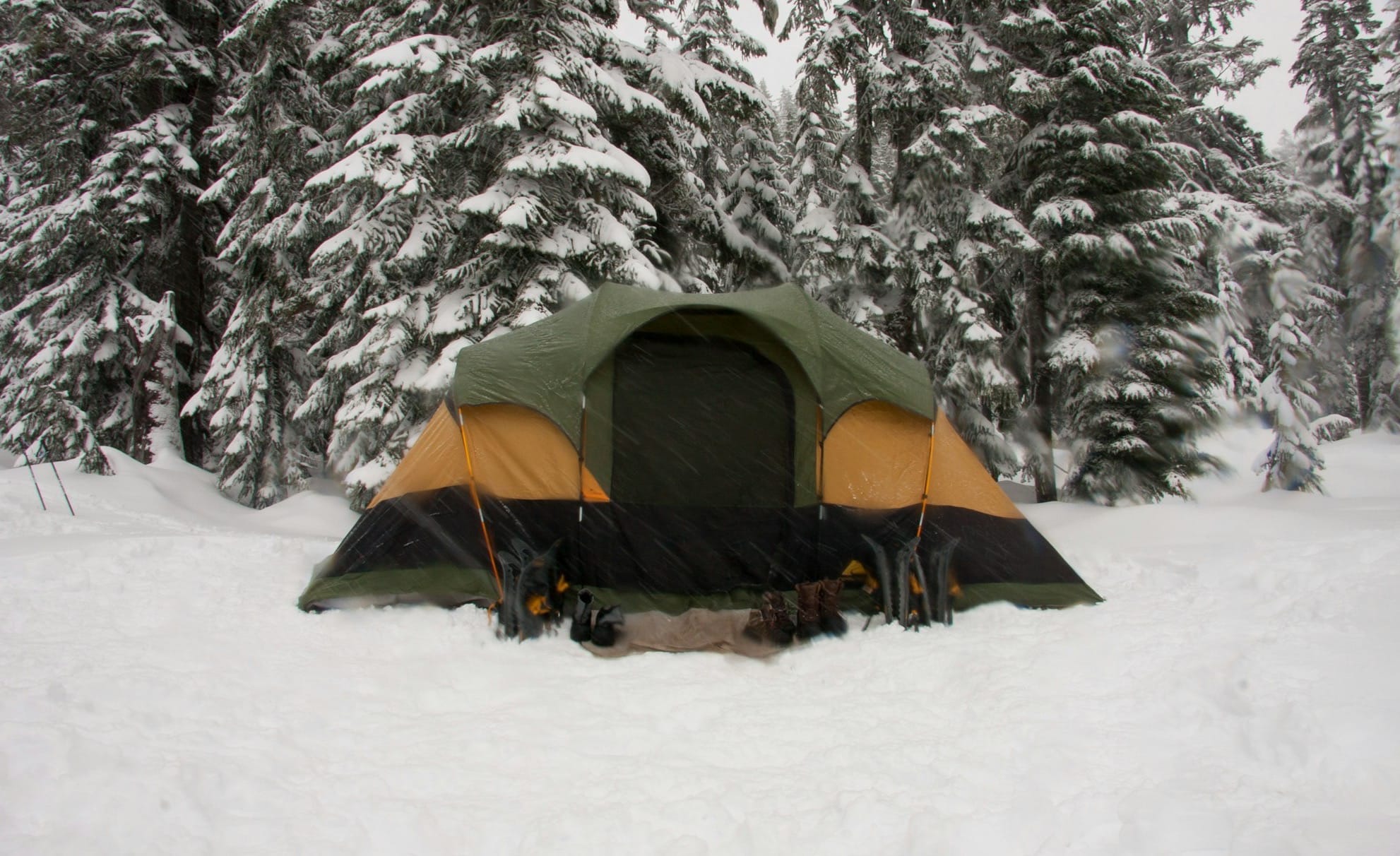
Setting up a winter campsite requires understanding the terrain and ensuring survival and comfort amidst the snow.
You'll learn how to select an optimal spot and create the right shelter to protect against the cold, wind, and snow.
Finding and Preparing a Campsite
Your first step is to identify a safe location for your campsite.
Look for an area shielded from the wind and away from avalanche paths and hazard trees with heavy snow loads that could fall. Use landmarks for navigation as heavy snow can obscure trails.
Flat ground is preferable, but a slight incline can prevent cold air from settling.
| Do | Don't |
|---|---|
| Choose a spot protected by natural features | Camp in an open space exposed to elements |
| Check for avalanche risks | Disregard signs of potential avalanches |
| Consider proximity to water sources | Camp too close to waterways that may be unstable |
Once you've found a suitable location, use your snow shovel to compact the snow where you’ll set up your tent.
Compacting creates a solid foundation, preventing you from sinking during the night. Always practice Leave No Trace principles, minimizing your impact on the environment.
Sheltering Techniques for Snow
- Snow shelter: Create a snow shelter such as a quinzhee or a snow cave only if you're skilled in constructing one. These shelters can be warmer than tents but require more effort and knowledge to build safely.
- Snow stakes: You'll need specialized snow stakes designed for holding your tent in the snow. Ensure they are deeply and securely driven into the compacted snow.
- Snow shovel: Keep a snow shovel inside or near your tent. You may need to dig out following snowfall during the night.
- Campfire: Use caution if making a campfire. Place stones in a circle to contain it and avoid lighting fires directly on the snow.
- Snow kitchen: Dig out a snow kitchen for cooking, with seats and windbreaks. Ensure you are downwind from your sleeping area to prevent smoke and smells from entering your tent.
- Melting snow: To obtain water, melt snow over your campfire or stove. Remember that you'll require additional fuel due to the lower efficiency in cold temperatures.
Clothing and Layering Systems
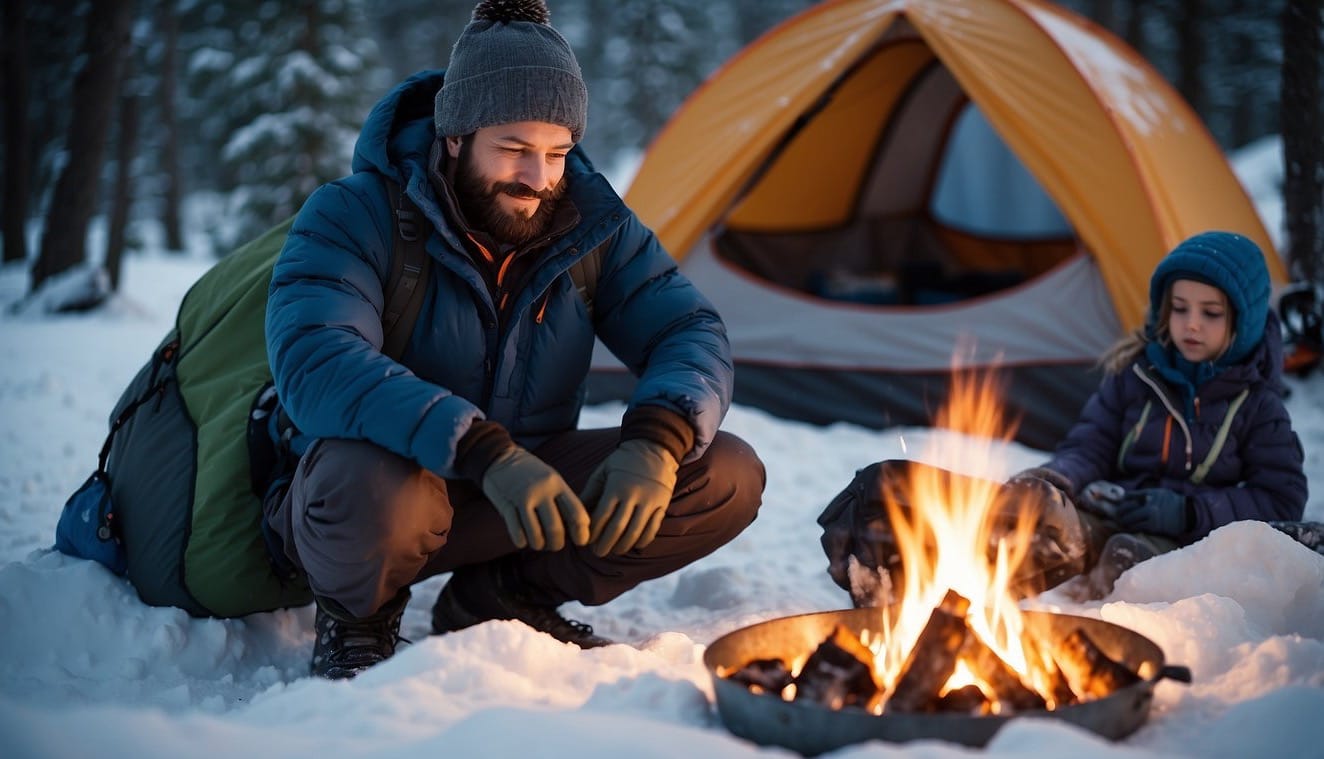
When preparing for winter camping, understanding the practical application of layered clothing is essential to regulate your body temperature and stay warm.
Here’s how to effectively use base and insulating layers, without neglecting the crucial outer layer protection.
Proper Use of Base Layers
Base layers are your first line of defense against the cold. They sit directly on your skin, serving to wick away moisture, keeping you dry. For this purpose:
- Thermal Underwear: Opt for materials that have excellent moisture-wicking properties, like merino wool or synthetic fibers.
- Socks: Wool socks are indispensable for foot warmth and comfort, especially while snowboarding or skiing.
Insulating and Outer Layers
Once you have your base layer set, you'll add insulating layers for warmth and an outer layer for weather protection.
- Mid-Layer: This layer retains body heat. Choose among options like a lightweight fleece or a heavier wool garment. Varieties may include pullovers and zipped jackets.
- Puffy Jacket/Down Jacket: A puffy jacket, often filled with down, provides significant warmth without much weight. It's an excellent insulating piece for less active times during your trip.
- Outer Layer: Your first defense against snow, wind, and rain, a sturdy waterproof jacket is indispensable. Look for breathable materials to prevent moisture buildup from sweat.
Food and Nutrition
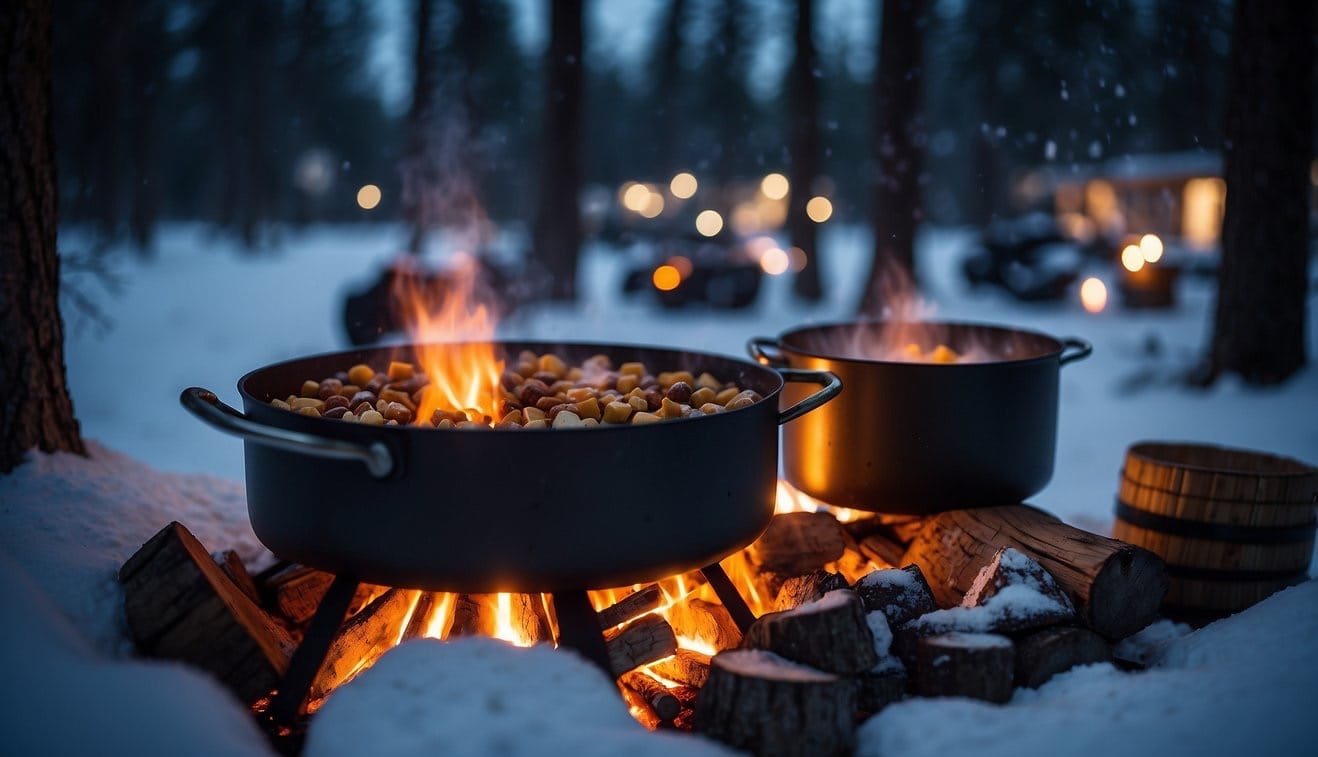
When winter camping, your body requires significantly more calories for warmth and energy.
Carefully balancing your food intake ensures you stay energized and warm throughout your adventure.
Calculating Necessary Caloric Intake
To meet the demands of a cold environment, you need approximately 3600 to 6000 calories per day. Your calorie needs will be influenced by variables such as weather conditions, your body size, and activity level.
Here's a simple way to calculate your caloric intake:
- Estimate Baseline Needs: Start with a base of 2000 calories per day.
- Add Activity Calories: High physical exertion can require an additional 200 to 300 calories per hour.
- Factor in Cold Weather: Add an extra 500 to 1000 calories for the cold.
This will give you a rough estimate of the total calorie intake necessary to sustain your activities during winter camping.
Prepackaged vs. Fresh Food Options
Prepackaged foods are often lightweight and convenient, making them a standard choice for winter camping. However, consider the nutritional value and satiety of these options.
- Protein bars, trail mix, and oatmeal with dried fruits provide quick, nutrient-dense snacks.
- Dehydrated meals offer a balance of carbs, protein, and fats, acting as a hearty meal option.
- Hot beverages like tea and coffee not only contribute to hydration but also provide warmth and comfort.
On the other hand, fresh food options can be rewarding. Eggs and pre-cooked bacon afford a filling breakfast, while a "Dutch Oven Cowboy Stew" offers a robust and satisfying dinner. These provide a chance to enjoy familiar textures and tastes, contributing to a better camping experience. Always ensure your foods can withstand the cold temperatures without spoiling.
For hydration, carry insulated water bottles capable of maintaining the temperature of both hot and cold liquids. Using a hot water bottle can also serve dual purposes: heat and hydration. Remember to drink regularly to avoid dehydration, a common but often overlooked risk in cold climates.
Tools and Equipment
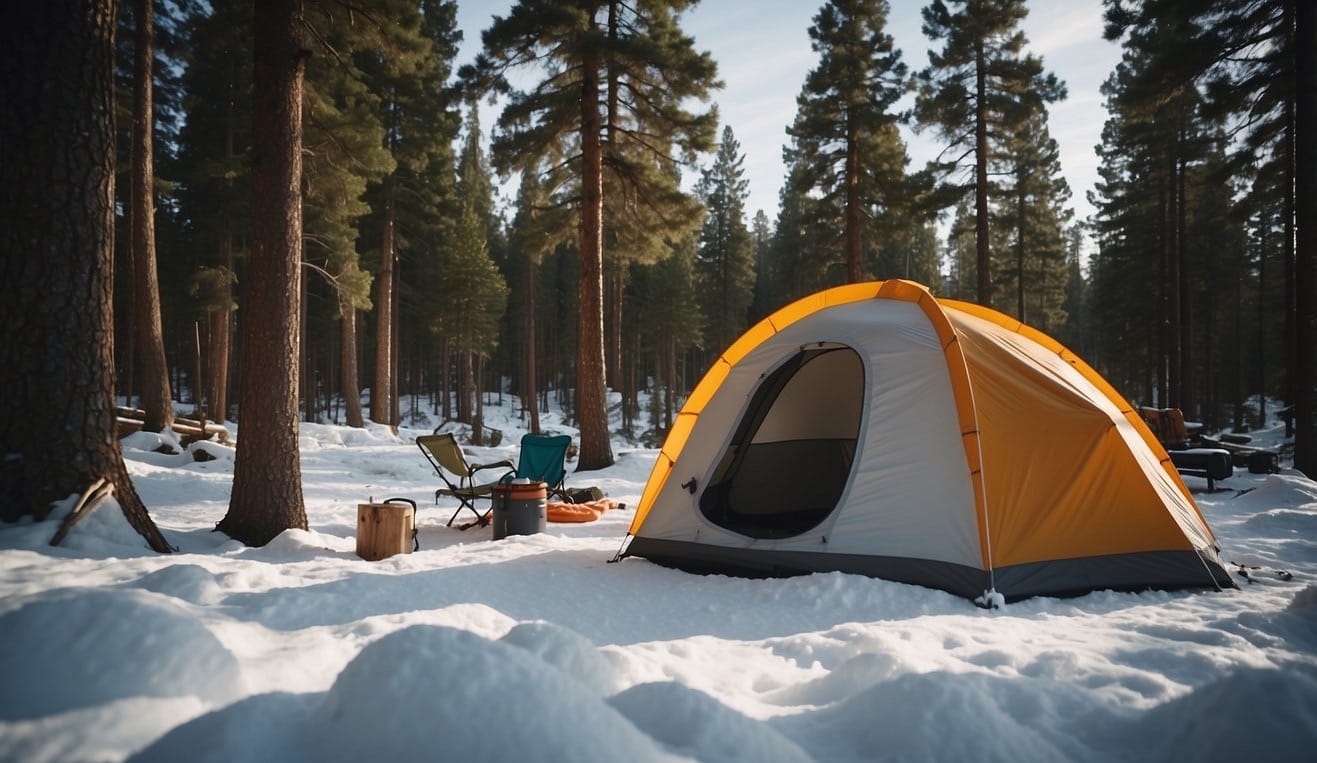
For winter camping, your tools and equipment are critical for safety and enjoyment. You'll need a specific set of gear tailored to cold environments, including sturdy shelters and devices for navigation under harsh conditions.
Navigation and Communication Devices
Your ability to navigate and communicate in winter environments could be life-saving. So, make sure to carry GPS devices and map and compass as reliable tools even in the face of extreme weather or loss of signal.
- GPS Device: Easy to carry and often comes with additional features like altimeters.
- Maps: Waterproof, winter-specific topographical maps.
- Compass: Opt for a global needle compass for accurate readings.
Survival Gear Essentials
Your survival gear must be effective against the cold and snow. Primary among these are a backpack able to carry all essentials, a sturdy shovel for snow digging tasks, and snowshoes or a splitboard for easier movement across snow.
Lighting: A headlamp is necessary for the shorter daylight hours; ensure it has a long battery life.
First Aid: A well-stocked first aid kit conforming to the "ten essentials" principle is mandatory.
Shelter tools:
- Snow Shovel: Lightweight yet durable for creating windblocks or snow shelters.
- Ice Axe: Crucial for treacherous snow and ice terrain.
Transport:
- Snowshoes/Splitboard: For deep snow conditions.
- Cross-country Skis/Snowboard: Depending on your preference for travel across snow.
Make sure to keep a winter camping checklist handy to ensure all necessary gear is included before departure. This includes checking the working condition of each item and familiarizing yourself with its use.
Maintaining Comfort and Safety
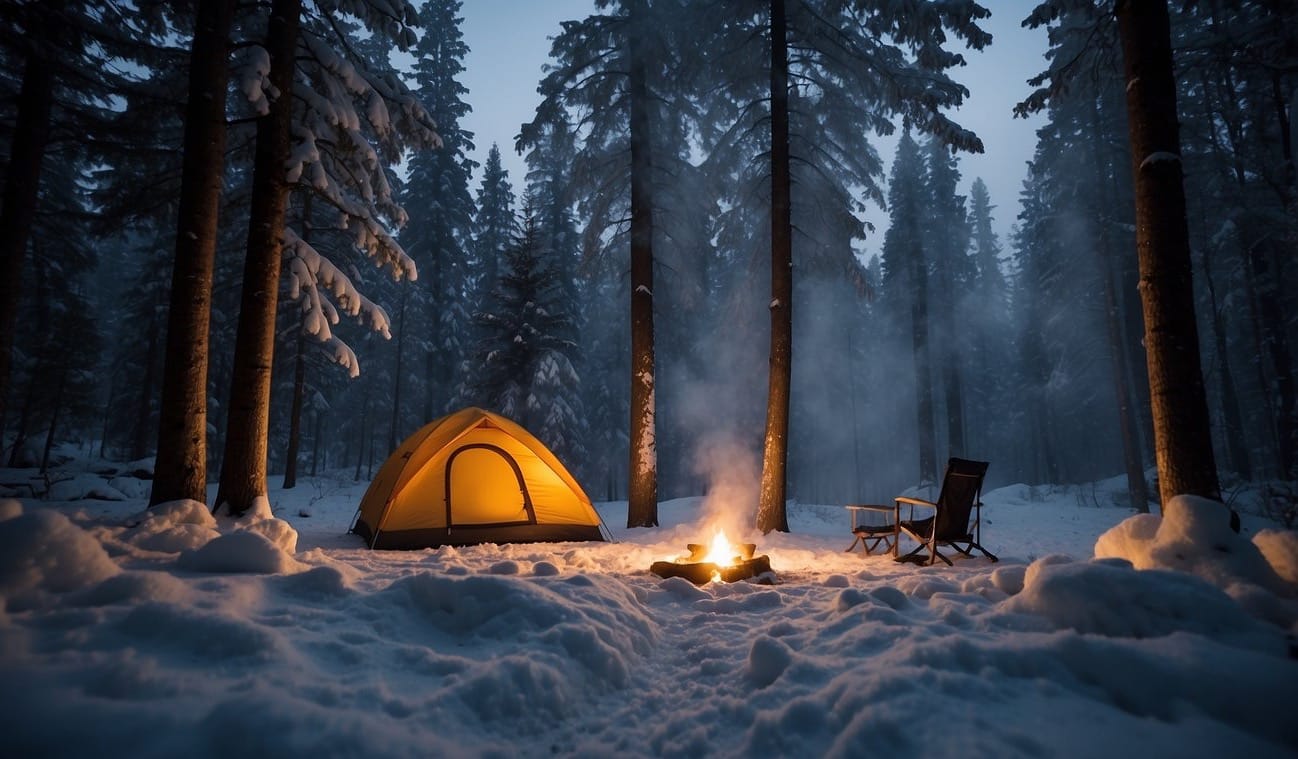
In winter camping, your comfort and survival hinge on staying warm and recognizing the signs of cold-weather dangers. The key to a safe and enjoyable trip lies in preparation and understanding of proper gear and conditions.
Staying Warm and Dry
Securing the right clothing and insulation are paramount.
Dress in breathable, moisture-wicking layers, starting with a synthetic or wool base layer to keep sweat off your skin. Add an insulating layer like a fleece, followed by a waterproof and windproof outer shell to protect against the elements.
- Clothing: Prefer materials like wool or synthetics that retain warmth when wet.
- Footwear: Waterproof, insulated boots are essential to keep your feet dry and warm.
A high R-value sleeping pad paired with an appropriate sleeping bag is your barrier against conductive heat loss through cold ground.
Ensure your tent has a reliable shelter structure to withstand wind and snow loads. You can also consider a portable heater for added warmth, but be aware of the need for ventilation to avoid carbon monoxide buildup.
Managing Frostbite and Hypothermia
- Frostbite: Protect extremities—fingers, toes, nose, and ears—with insulated gloves, socks, and face coverings. Change out of wet clothes immediately to prevent heat loss.
- Hypothermia:
- Signs — Shivering, exhaustion, confusion, fumbling hands, memory loss, or slurred speech.
- Emergency — If symptoms are present, seek emergency help, remove any wet clothing, warm the center of the body first, and provide warm beverages if the victim is conscious.
Prepare by knowing how to recognize and treat these conditions.
Always have an emergency plan and gear because even well-prepared camps can face unexpected challenges like avalanches.
Camp in locations shielded from the wind and steer clear of avalanche zones, maintaining privacy and safety.

Frequently Asked Questions
Before heading out into the winter wilderness, it's essential to be well-equipped and informed. This section answers some common queries that might arise as you prepare for a cold weather camping trip.
What are the essential gear items for winter camping?
For winter camping, you must have a four-season tent, a sleeping bag rated for low temperatures, an insulated sleeping pad, a stove suitable for cold weather, layers of clothing (preferably moisture-wicking and insulating), waterproof boots, and a cold-weather rated backpack. Don't forget accessories like a beanie, gloves, and thermal socks.
How do you properly insulate a tent for cold weather conditions?
To insulate your tent, use a waterproof and windproof footprint under your tent to reduce ground heat loss. Inside, lay insulated foam pads or a thick layer of dry leaves or pine needles. Cover the tent with a specialized insulated blanket or tarp to trap heat, and use a four-season tent designed to handle snow accumulation.
At what temperature does winter camping become unsafe?
Winter camping can become unsafe at temperatures below 20 degrees Fahrenheit, especially if you're not properly equipped or experienced. Each person's tolerance varies, so understand your limits and stay informed about weather forecasts. Hypothermia is a risk at these temperatures if you're not prepared.
Can you provide tips for staying warm while camping in sub-zero temperatures?
Stay warm by layering your clothing; use thermal base layers and down jackets. Keep extremities covered with thermal gloves and socks. Consume warm, calorie-dense foods and stay hydrated with warm drinks. Before sleeping, use a hot water bottle inside your sleeping bag and keep a beanie on to reduce heat loss from your head.
What activities are popular during a winter camping trip?
Popular winter activities include snowshoeing, cross-country skiing, ice fishing, wildlife tracking, and photography. Short day hikes and building snow shelters are also enjoyable. Always check the weather and daylight hours, and bring necessary gear for your planned activities.
What are some effective cold weather camping hacks?
Effective cold weather camping hacks include using candle lanterns for added warmth. You can also apply a layer of foam insulation to your water bottle to prevent freezing. Additionally, dress in layers that you can adjust as needed. Also, remember to clear the snow from the ground before setting up camp to prevent moisture seepage. Lastly, use a sleeping bag liner for additional warmth.

